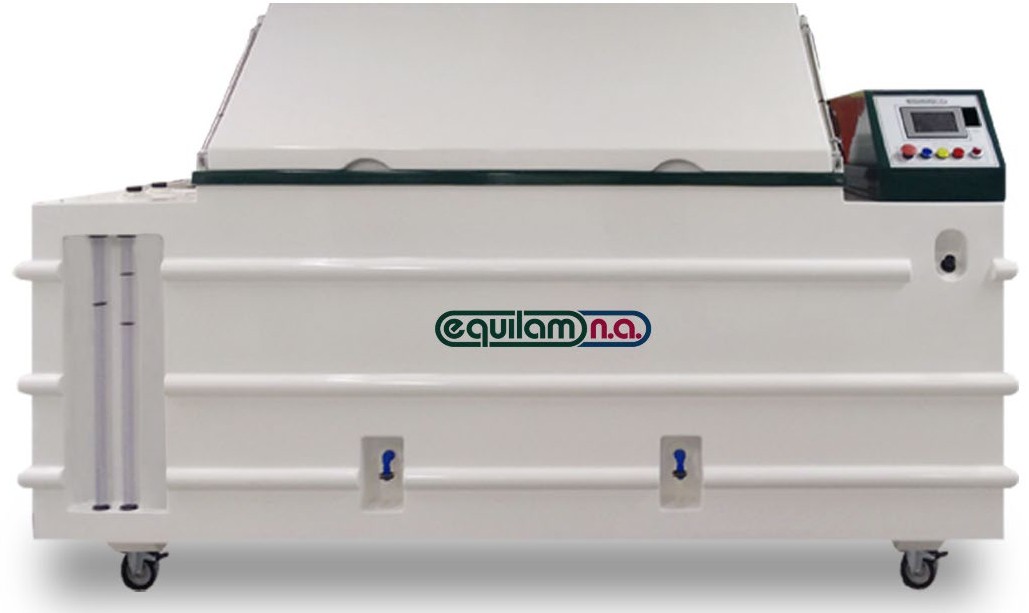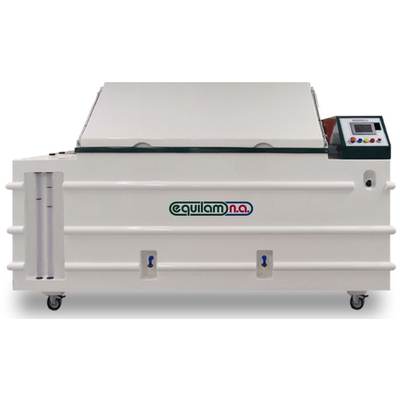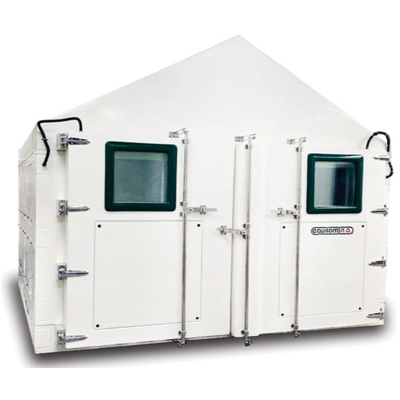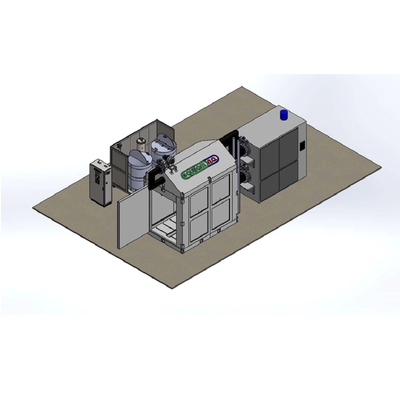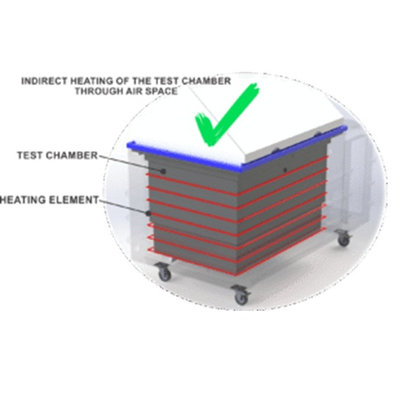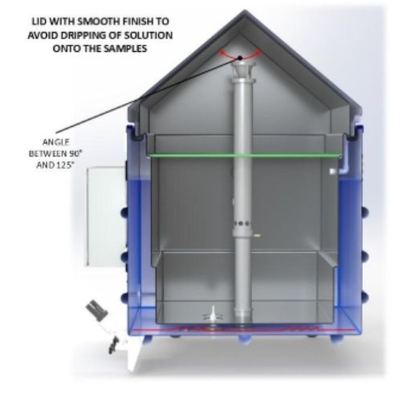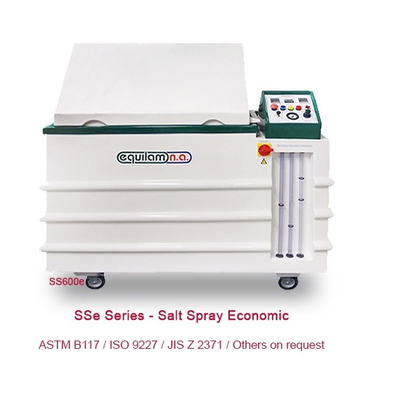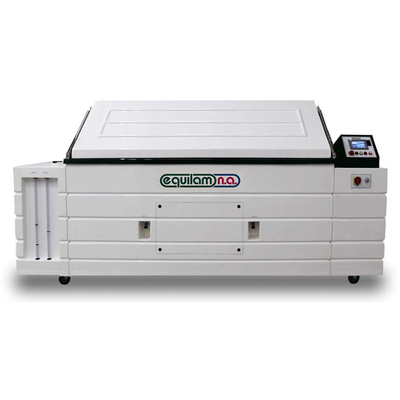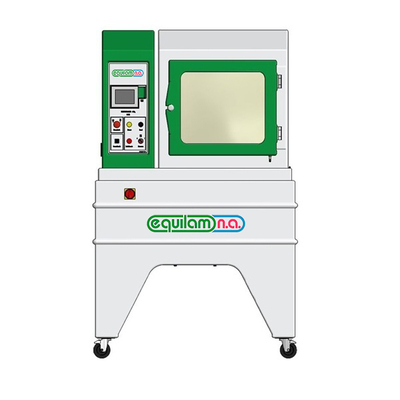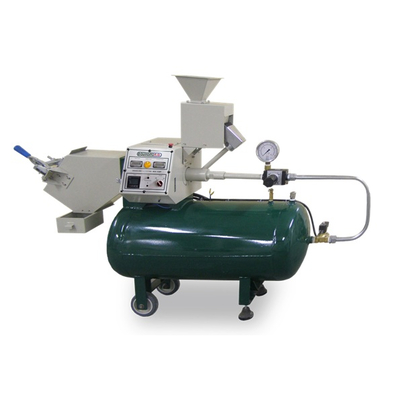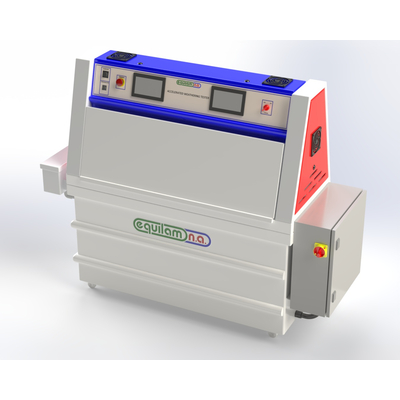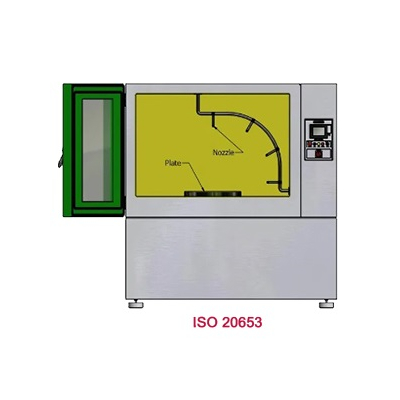Cyclic Corrosion Test CORR Auto
C.C.T CORR AUTO Series
Equilam N.A - USA
12 months
The EQUILAM NA CORR AUTO model cyclic corrosion test chambers provide one of the most realistic simulations for accelerated corrosion testing. Some studies indicate that the test results closely resemble those obtained in outdoor exposure. Contact Us: Email: secovina@vnn.vn OR Mr. Felipe Rojo, Email: frojo@equilamna.com , Phone: 1.754.900.7816
secovina@vnn.vn
HOTLINE TƯ VẤN : 0908866933
Cyclic Corrosion Test CORR Auto
The EQUILAM NA CORR AUTO model cyclic corrosion test chambers provide one of the most realistic simulations for accelerated corrosion testing. Some studies indicate that the test results closely resemble those obtained in outdoor exposure.
The C.C.T CORR AUTO corrosion chambers allow programming of cycles with time intervals (ramp or plateau) combined with the following modes:
Salt Spray (Salt Fog)
Stress or Spray (oscillating or fixed – optional)
Immersion (optional)
Warm saturated humidity condensed onto the samples (ISO 6270-2 – CH – ASTM D2247)
Warm saturated humidity – water fog (ASTM D1735)
Climatic Mode: Temperature vs. Relative Humidity with programmable ramps and plateaus. Range: 50°F to 176°F (10°C to 80°C) – R.H: 10% to 85% (Table 01)
Low Temperature Mode: -22°F (-30°C), with heating and cooling and programmable ramps and plateaus.
Range: 176°F (80°C) to -4°F (-20°C)
Ultra Low Temperature Mode: -40°F (-40°C), with linear heating and cooling and programmable ramps and plateaus.
Range: 176°F (80°C) to -40°F (-40°C)
Salt Spray (Salt Fog) Mode:
Test specimens are placed inside the test chamber following technical standards or company-specific protocols. They are subjected to controlled fog with corrosive agents (acidic, basic, or saline) in a high-humidity environment, using solutions defined by industry standards.
Spray (Stress) Mode – Oscillating or Fixed:
Optional mode, also available in a suspended oscillating configuration (mounted at the top).
The climatic mode features electric heating elements that enable rapid temperature ramping, meeting the needs of automotive cyclic corrosion tests with short transition times.
Immersion Mode:
The solution is pumped into the test chamber, immersing the test specimens. This solution can be heated or kept at ambient temperature.
Cyclic Corrosion Test CORR Auto
Condensed Saturated Humidity Mode:
The test temperature can be set between 105°F (40°C) and 158°F (70°C) – R.H. 95% ~ 100%.
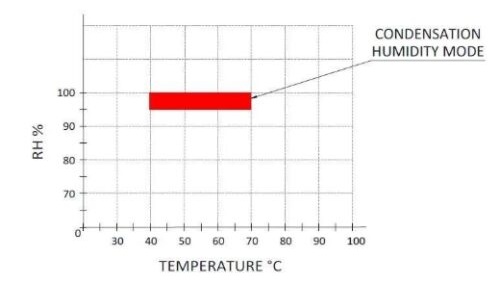
Water Fog Mode – ASTM D1735 (Optional):
Test specimens are placed inside the test chamber following established technical standards or company-specific protocols. They are exposed to a fog generated with deionized water, and the test chamber is maintained at high humidity and elevated temperature.
Climatic Mode:
With programmable temperature vs. relative humidity ramps and plateaus, using sensors inside the test chamber (optionally with a temperature sensor on the specimen to ensure realistic temperature performance). Wet bulb and dry bulb sensors ensure accurate relative humidity (R.H.) control within the chamber.
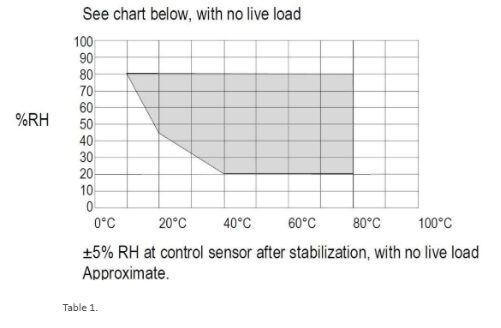
Low Temperature or Ultra Low Temperature Mode:
- Low Temperature: -22°F (-30°C), with cooling and heating in the range of 176°F (80°C) down to -4°F (-20° C).
- Ultra Low Temperature: -40°F (-40°C), with linear cooling and heating from 176°F (80°C) down to -40°F (-40°F).
For additional performance options, please contact us.
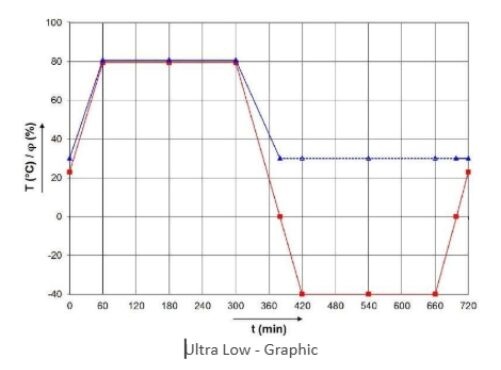
Caution Regarding Cross Chemical Contamination:
When the cyclic corrosion chamber r has previously been used for an acid test—AASS / CASS—or with any other solution (chemical product – corrosive agent) not specified by standards such as ASTM B117, NSS–ISO 9227, or NSS–JIS Z2371, or if it has been used for any purpose other than neutral salt spray testing, the chamber becomes chemically contaminated. The reverse scenario also results in contamination.
Therefore, the CCT CORR AUTO chamber must undergo a thorough cleaning procedure until the pH level complies with the guidelines established by technical standards. The corrosivity of the chamber must also be verified to ensure it does not significantly affect the results of subsequent tests.
It is essential to note that this cleaning process is challenging, and achieving full decontamination is nearly impossible.
Rack Material Requirements:
Racks must be constructed from non-metallic materials. If wood is used, it must be properly coated to prevent unwanted substances from interfering with the final test results.
Specimen Positioning:
Specimens should preferably be supported directly on the chamber floor. Plastic or slotted rubber profiles are suitable for supporting flat panels.
Suspension using glass hooks or waxed string is also acceptable, provided that the specimens maintain the specified positioning, which may require the use of secondary supports under the specimens.
Main Technical Standards for Cyclic Corrosion:
ASTM D5894
ASTM G85
BMW PA-P-029
FORD CETP: 00.00-L-467
FORD TM 00.00-L-467
GMW 14872
Honda CCT
Honda Structural
IEC 60068-2-52
ISO 11997-1 and 2
ISO 12944
ISO 12944
ISO 16701
ISO 19453-4
JAGUAR TPJLR.52.252
JAGUAR TPJLR.52.265
JAGUAR TPJLR.52.554
JOHN DEERE JDQ 178
MERCEDES BENZ MBN 10518
MIL STD 810D Method 509.2
MIL STD 883 Method 1009.5
NISSAN CCT I,II,IV
RENAULT D 17 2028 C
RTCA/DO-160E
SAE J2334
SCANIA STD 4233
SCANIA STD 4319
SCANIA STD 4445
TESLA TP0000808
TOYOTA TSH 1555G
VDA 232-102
VDA 621-415
VOLVO STD 1027,1375
VOLVO STD 1027,14
VOLVO STD 423-0014
VW PV1209
VW PV1210
YAMAHA YGK-8-501
|
Model |
CCT CORR AUTO 15-450 |
CCT CORR AUTO 28-810 |
CCT CORR AUTO 45-1200 |
CCT CORR AUTO 110-3100 |
CCT CORR AUTO 135-4000 |
|
I.D. (w x d x h) |
|
|
|
|
|
|
Inches |
32.3” x 25.6” x 30.7” |
46.9” x 32.8” x 32.7” |
59.” x 35.4” x 35.4” |
98.4” x 49.2’ x 39.0” |
122” x 49.2” x 39.0” |
|
mm |
820 x 650 x 780 |
1,190 x 820 x 830 |
1,500 x 900 x 900 |
2,500 x 1,250 x 991 |
3,100 x 1,250 x 991 |
|
No included lid. |
|
|
|
|
|
|
Internal Volume Included lid. |
|
|
|
|
|
|
Cu.ft |
14.7 |
28.6 |
42.9 |
109.4 |
135 |
|
Liters |
415 |
810 |
1,200 |
3,097 |
3,840 |
|
|
|
|
|
|
|
Note: The C.C.T CORR AUTO series chambers are designed as a monoblock, meaning the solution tank and the Bubble Tower (Saturator) are integrated into a single unit.
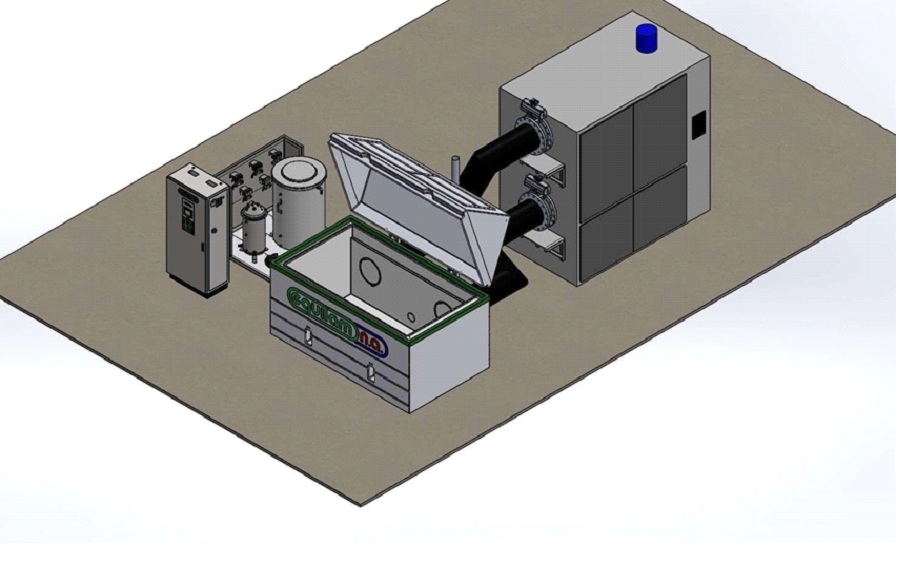
Illustrative photo C.C.T. CORR AUTO 45-1200
|
Series |
W.C.C.T CORR AUTO |
||||
|
Model |
14-500 |
18-700 |
40-15000 |
55-20000 |
77-30000 |
|
I.D. (w x d x h): |
|
|
|
|
|
|
Inches |
78.7” x 78.7 x 98.4” |
118.1” x 78.7” x 98.4” |
137.8” x 137.8” x 98.4” |
196.9” x 137.8” 98.4” |
275.6” x 137.8” x 98.4” |
|
mm |
(2,000 x 2,000 x 2,500) |
(3,000 x 2,000 x 2,500) |
(3,500 x 3,500 x 2,500) |
(5,000 x 3,500 x 2,500) |
(7,000 x 3,500 x 2,500) |
|
No “V” celling |
|
|
|
|
|
|
Door clearance: |
|
|
|
|
|
|
Inches |
59.0” x 82.6” |
59.0” x 82.6” |
118.1” x 83.8” |
118.1” x 83.8” |
118.1” x 83.8” |
|
mm |
1,500 x 2,100 |
1,500 x 2,100 |
3,000 x 2,130 |
3,000 x 2,130 |
3,000 x 2,130 |
|
Internal Volume Included lid: |
|
|
|
|
|
|
Cu.ft |
494.4 |
642.7 |
1,412 |
1,942 |
2,719 |
|
M³ |
14 |
18.2 |
40 |
55 |
77 |
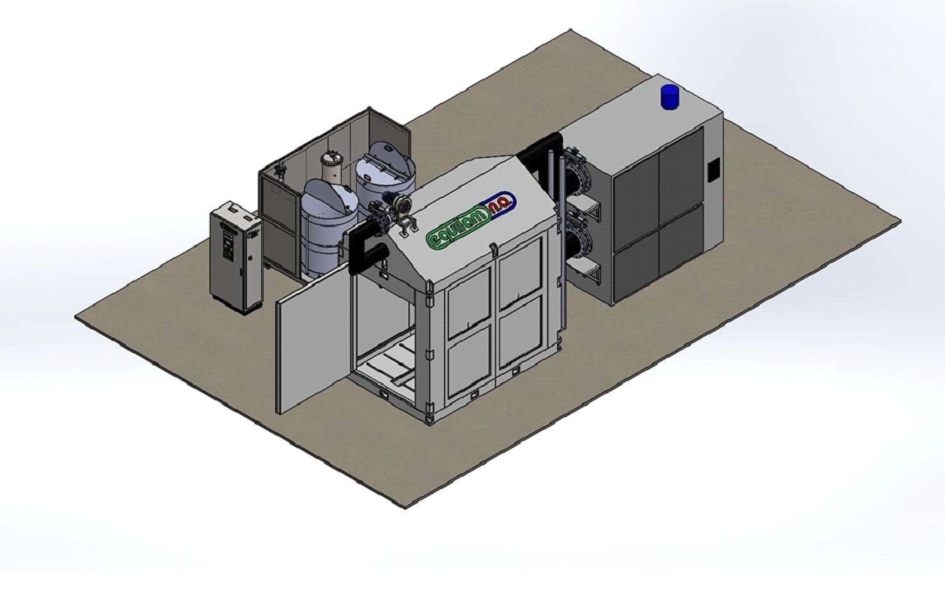
Illustrative photo W.C.C.T CORR AUTO 14-500
WHY EQUILAM NA - Cyclic Corrosion Test CORR Auto
Our Salt Spray chambers are constructed both internally and externally from reinforced plastic (US PATENT 10371623), meaning there are no metallic components inside the chamber. This ensures that no galvanic corrosion occurs and that final test results remain accurate and reliable.
The test chamber is heated indirectly through a heated air jacket that surrounds the entire chamber, providing excellent temperature stability and uniformity, ensuring consistently accurate and reproducible test results. (US PATENT 10371623)
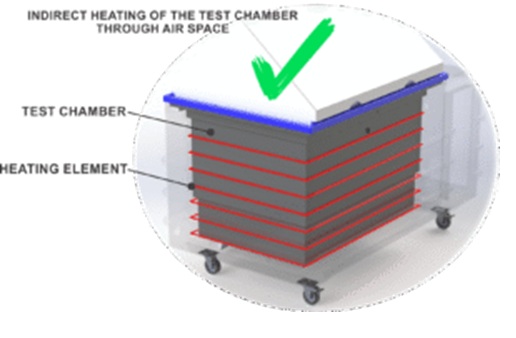
100-Degree Angled Lid:
Made of high-strength plastic resistant to scratching by salt crystals.
(Acrylic can be scratched by salt crystals, which may cause dripping onto the samples—an undesirable condition.)
If the user requires visibility of the samples, it is important to note that direct observation during the test is not possible.
Our solution is the inclusion of side windows in the lid, which avoids dripping onto the specimens.
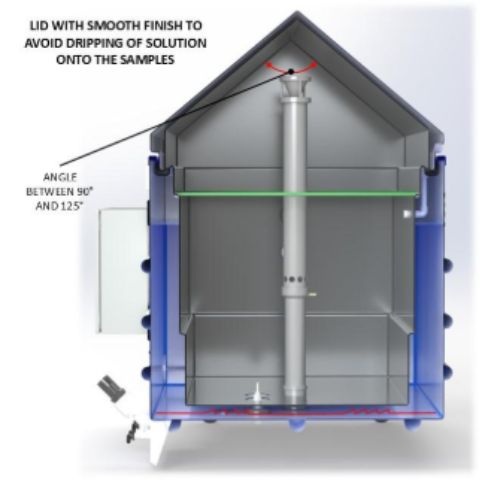
A minimum test chamber volume of 1000 liters is recommended (excluding the volume of the lid). Smaller chamber volumes can cause turbulence, which may distort the final test results.
Walk-in chambers are generally constructed with a sloped roof angled between 90 and 125 degrees. Properly positioned and directed spray nozzles help prevent accumulation and dripping on the ceiling. Nozzles can be located on the ceiling or on the floor, angled upward at 30° to 60° over a walkway. The number of nozzles depends on the type and capacity of the system and is related to the test space area. Small solution reservoirs are required inside the chamber, with controlled levels.
The main characteristics of a walk-in type chamber, which significantly differ from a standard laboratory model, include:
- Electrical panel with UL label, splash and dust protection.
- Bubble Tower (Air Saturator Tower or Humidifying Tower) made of stainless steel
- All electrical components with UL label
- Emergency stop switch for instant shutdowns to prevent accidents
- Lock-type switch that allows safe shutdowns for preventive or corrective maintenance
- Safety relay, which cuts power to the electrical circuits upon detecting faults or accident risks
- LED signal panel with industrial-grade colored indicators providing visual and audible signals to show machine status and process stages
- Solution level, deionized water in the Saturator Tower, and water jacket levels are located at the front of the chamber and are easily visible to the operator. In addition, electronic safety level sensors are included.
Bình luận
Sản phẩm cùng loại
Salt Spray (Salt Fog)
Cyclic Corrosion Test (C.C.T)
Water Resistance Test Chamber – Humidity Test
Kesternich Corrosion Chamber – SO2
Gravelometer / Stone Chip Resistance Test
Accelerated Weathering Tester – UV
IPX9K Code
Fanpage

